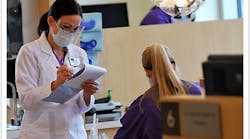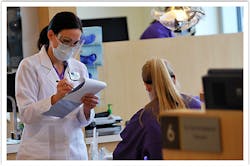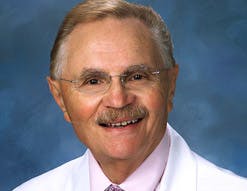Transforming Dental Hygiene Education: the future of the dental hygiene profession
Oct. 4, 2013
The Santa Fe Group, the American Dental Hygienists’ Association (ADHA), and the ADHA Institute for Oral Health held a national symposium to examine the dental hygiene educational system through the lens of its history, the current environment, and the future health care and oral health care needs of the public.Transforming Dental Hygiene Education was conducted within the context of health care reform enacted by the Patient Protection and Affordable Care Act (ACA). The Symposium brought together a wide range of stakeholders to view these issues. They were: dental hygiene program directors and faculty, registered dental hygienists, advocacy organizations, public and private purchasers, policy makers, chief dental officers, dental insurance providers, health educators, professional associations, and private industry members.
The meeting was dedicated to Founding Member Dominick DePaola, DDS, PhD, 1942-2013. He was honored for his passion for the organization’s mission and vision, and his influence was one of the keys to the success and influence achieved throughout the years.
Dominick DePaola, DDS, PhD The group explored how the changes in the health care environment could inform the transformation of the dental hygiene profession. We identified the extensive range of roles that dental hygienists can assume in current and innovative models of health care with and beyond oral health care. The group also examined and discussed the skills, attitudes, and competencies that will be needed by dental hygienists as we forge ahead to meet the changing needs of the “future” public. This served to provide guidance for ADHA and the profession, as we strive to implement the vision, mission, and goals of the organization and the profession. The main challenges were to identify how the profession can better serve the health and wellness needs of society, and what roles dental hygienists can assume in the current and future health care systems. Most of us are familiar with the six roles of dental hygiene, identified by the ADHA a number of years ago. Clinician, Educator, Researcher, Administrator/Manager, and Advocate are the six roles. We also know that most dental hygienists are not prepared in their entry level programs for anything other than private practice. The question arose as to how we must modify the current dental hygiene curricula to meet the ever-changing needs of society and the dynamic health care system. We discussed the resources that will be needed, and what models exist or can be developed to assist us as we transition into the future. The other important piece to the puzzle is whether health care systems or funders can develop a sustainable business model for dental hygienists to improve the public’s health and welfare. The meeting was opened with opening remarks by Linda Niessen, DMD, MPH, MPP, President of the Santa Fe Group, and Denise Bowers, RDH, PhD, President of the ADHA. We began with a dynamic presentation by Michael Sparer, JD, PhD, Department Chair, Health Policy & Management, Columbia University Mailman School of Public Health. As an aside, Dr. Sparer is married to a dental hygienist! His keynote presentation was entitled "The Transformation of the U.S. Health Care System" as it goes through a radical transformation, partly due to the ACA and numerous trends in the health care marketplace. Dr. Sparer talked about these trends, and how the ACA will dramatically increase the number of people with health insurance. Subsidized health insurance exchanges were slated to be implemented as of October 1, 2013. Medicaid enrollment will significantly expand in January 2014, and all Americans will be mandated to have some type of health insurance in 2014.
Michael Sparer, JD, PhD The ACA has three key goals: health coverage for the uninsured; containing the cost of health care; and a better and more efficient delivery system. Regardless of your political persuasion, and your beliefs, the health care system is changing dramatically, and these trends will shape the role of the next generation of dental hygienists. Trends include expanding the role of the non‐physician provider and the non‐traditional retail clinic, with a focus on public health and prevention. We will see advances in personalized medicine and an increased use of health information technology. Dr. Sparer discussed the changing role of the oral health provider, with a “scoping down” of the dentist and the dental hygienist, and a “scoping up” of the dental hygienist and the health home. The key question he posed is, “who does what?” In summary, Dr. Sparer asked if dental hygiene education should have a new mission. What will the next generation of dental hygienists look like? What will our role be, what skills will be needed, and will a new curriculum need to be developed? Every dental hygienist should know about the health care system. The U.S. health care system is transforming, the role of the dental hygienist will change, the key is to manage the change and to exercise leadership. The Mission of the Santa Fe Group: the Santa Fe Group fosters policy and initiates actions to improve the health and well-being of the public. We accomplish this mission by analyzing and disseminating health program and policy information, by creating networks of concerned citizens from all walks of life, and developing advocacy programs to promote change for improved health. The Vision is: To help shape the future of health through an action-oriented think tank that has a passion for the public good. Read more about the group at: http://santafegroup.org/. More about this fabulous meeting in future issues!










